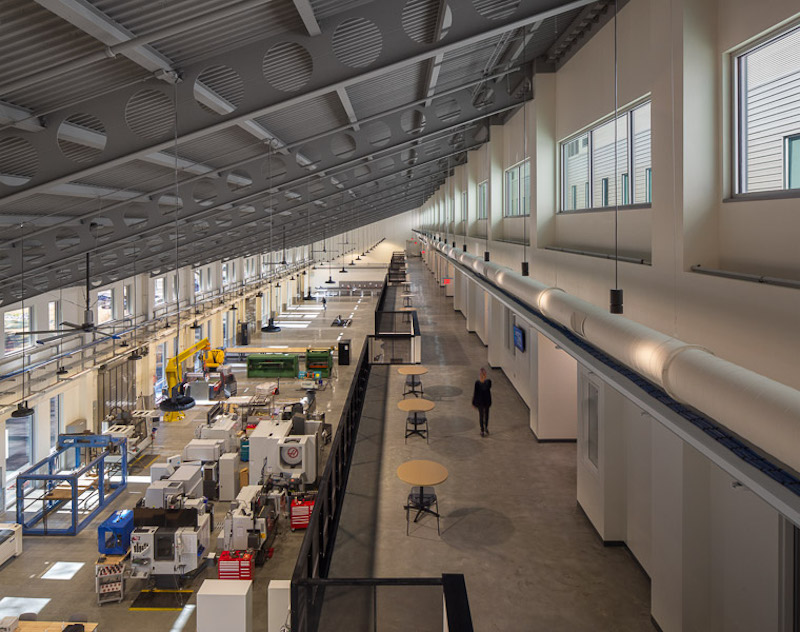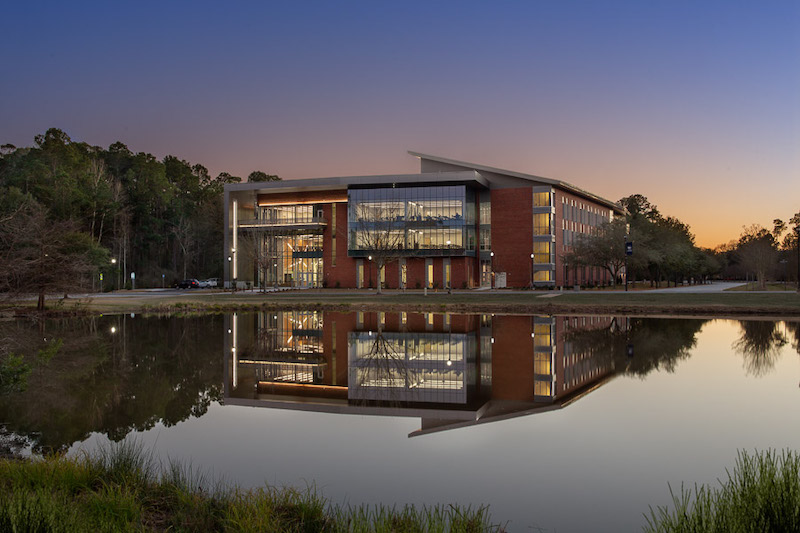Georgia Southern’s new $60 million, 140,625-sf Engineering and Research Building has completed construction. The building was designed to facilitate academic and institutional partnerships, inspire creative engineering, and accelerate academic success for students in the College of Engineering and Computing.
The new facility centralizes various departments and multiple disciplines whose activities previously took place in three buildings. The building will enhance the university’s research capabilities as well as opportunities for faculty to engage students in hands-on research and teaching projects.
Applied research spaces with a strong focus on manufacturing engineering, civil engineering, electrical and computer engineering, and mechanical engineering are all housed in the three-story building. Workspaces can be easily reconfigured for various uses, projects, and applications while also providing students with access to industry-grade equipment and expanded opportunities for undergraduate research.

In total the building houses more than 35 labs including robotics and automated manufacturing labs, a traditional and CNC finishing lab, a materials science and characterization lab, an industrial instrumentation and controls lab, a joining and welding lab, and a renewable energy roof deck lab (solar, wind, weather). Metal and non-metal 3D-printing spaces are also included.
The building also includes one of the Southeast’s only Class 3 cleanrooms, which is necessary for manufacturing or scientific research that requires and environment with very low levels of pollutants such as dust, microbes, vapors, or aerosol particles.
21 research spaces, six classrooms, four conference rooms, 27 offices, and a 1,500-sf colloquium space with a 500-sf balcony are also included.
SmithGroup was the project architect. JE Dunn Construction built the facility.
Related Stories
| Oct 17, 2011
Clery Act report reveals community colleges lacking integrated mass notification systems
“Detailed Analysis of U.S. College and University Annual Clery Act Reports” study now available.
| Oct 14, 2011
University of New Mexico Science & Math Learning Center attains LEED for Schools Gold
Van H. Gilbert architects enhances sustainability credentials.
| Oct 12, 2011
Bulley & Andrews celebrates 120 years of construction
The family-owned and operated general contractor attributes this significant milestone to the strong foundation built decades ago on honesty, integrity, and service in construction.
| Sep 30, 2011
Design your own floor program
Program allows users to choose from a variety of flooring and line accent colors to create unique floor designs to complement any athletic facility.
| Sep 23, 2011
Okanagan College sets sights on Living Buildings Challenge
The Living Building Challenge requires projects to meet a stringent list of qualifications, including net-zero energy and water consumption, and address critical environmental, social and economic factors.
| Sep 14, 2011
Research shows large gap in safety focus
82% of public, private and 2-year specialized colleges and universities believe they are not very effective at managing safe and secure openings or identities.
| Sep 7, 2011
KSS Architects wins AIA NJ design award
The project was one of three to win the award in the category of Architectural/Non-Residential.
| May 18, 2011
Major Trends in University Residence Halls
They’re not ‘dorms’ anymore. Today’s collegiate housing facilities are lively, state-of-the-art, and green—and a growing sector for Building Teams to explore.
| May 18, 2011
Raphael Viñoly’s serpentine-shaped building snakes up San Francisco hillside
The hillside location for the Ray and Dagmar Dolby Regeneration Medicine building at the University of California, San Francisco, presented a challenge to the Building Team of Raphael Viñoly, SmithGroup, DPR Construction, and Forell/Elsesser Engineers. The 660-foot-long serpentine-shaped building sits on a structural framework 40 to 70 feet off the ground to accommodate the hillside’s steep 60-degree slope.
















